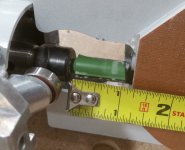ztifpatrick
Member
- Joined
- Jul 29, 2007
- Messages
- 10
I tend to use the hard sanding pad on my 150 sanders, but I have to sand some walnut veneered ply with walnut edging. The edging is about 3/4" wide and practically flush with the top. It does need some sanding and there is a fine line of glue showing. So what pad would use use to bring these two surfaces perfectly flush?
The issue to be avoided is of course sanding thru the veneer.
The issue to be avoided is of course sanding thru the veneer.

